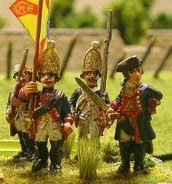 Here are photos of my Freeman's Farm game as I hosted it at the Carnage '07 Convention as part or the Northern Conspiracy's participation in the Centuries of Conflict, 18th century theme games. I didn't win any prized for beauty, as my convention games are built for portability and gaming enjoyment, but everyone had a great time.
Here are photos of my Freeman's Farm game as I hosted it at the Carnage '07 Convention as part or the Northern Conspiracy's participation in the Centuries of Conflict, 18th century theme games. I didn't win any prized for beauty, as my convention games are built for portability and gaming enjoyment, but everyone had a great time.This was a re-play of the test game I hosted last month at our club's game night. The game night game saw the British thoroughly demolishing the Americans in good order well before the German right flank even reached the table. In this re-fight, the Americans drew first blood and kept the pressure on the 'Thin Red Line' throughout the game returning the earlier damage in spades. This go-around was a complete American victory. I'll put this scenario down as 'wargame balanced'. Another one I can pull out knowing I've got the forces balanced just about right. One of the great things about Volley&Bayonet is that you can fight a battle of this size, with gamers new to the rules, in under 3 hours. We played this scenario to completion, at Carnage, with 3 people who hadn't ever played V&B before and finished the game in three hours. About an hour into the game everyone was running their own tables and playing the game pretty much un-assisted by the GM.
Congratulations and thanks are due to everyone who participated in the Centuries of Conflict, supporting this great continuation of our old Tricon Convention. Next year's theme will be 19th Century: Napoleonics, American Civil War and the like. For many more beautiful photos of the wargames from Carnage, please see the Northern Conspiracy events page for the convention.





















































